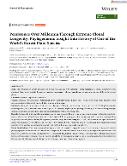| dc.contributor.author | Mráz, Patrik | |
| dc.contributor.author | Flašková, Lenka | |
| dc.contributor.author | Chrtek, Jindřich | |
| dc.contributor.author | Mrázová, Viera | |
| dc.contributor.author | Puşcaş, Mihai | |
| dc.contributor.author | Josefiová, Jiřina | |
| dc.contributor.author | Záveská, Eliška | |
| dc.date.accessioned | 2025-01-27T14:11:03Z | |
| dc.date.available | 2025-01-27T14:11:03Z | |
| dc.date.issued | 2025 | |
| dc.identifier.uri | https://hdl.handle.net/20.500.14178/2829 | |
| dc.description.abstract | Aim: The evolutionary history of European alpine plant species with medium to large geographical ranges is relatively well explored. Here, we investigate the genetic structure and diversity of an extremely narrow endemic and one of the world's rarest plants.Location: Eastern Carpathians, Romania.Taxon: Andryala laevitomentosa (Asteraceae), an evolutionarily isolated herb species with a worldwide range limited to five micropopulations distributed along a 1.8 km long mountain ridge.Methods: We used three plastid loci, nuclear ribosomal ITS and genome-wide, mostly nuclear 26,272 Single-Nucleotide Polymorphism (SNPs) obtained from RAD-seq data. We assessed haplotype and genotype diversity, dated the resulting phylogeographic structure, quantified seed production and inferred vegetative propagation.Results: Maternally inherited plastid markers and nuclear genomic data revealed a concordant pattern: (i) limited genetic diversity, with seven cpDNA haplotypes and 11 RAD-seq multilocus genotypes; (ii) a strong geographic structure corresponding to spatially isolated genets (clones). The species is likely of early Pleistocene origin (c. 2 Mya), and the estimated age of individual clones varied from c. 24 to 64 Kya. The average seed set assessed over 3 years was only 0.4%. However, the species reproduces veg by axillary and adventitious rosettes formed on rhizomes and roots, respectively.Main Conclusions: The strong trade-off between sexual and vegetative reproduction explains not only a deep and ancient phylogeographic structure but also the rarity of the species. Its survival depends almost entirely on vegetative reproduction. The genets of A. laevitomentosa are amongst the oldest clones ever documented in angiosperms. The persistence of these clones in situ for tens of thousands of years suggests an exceptional ability of this species to adapt to major climatic oscillations throughout the Pleistocene and Holocene and challenge our perception of the extent of resilience in plants. | en |
| dc.language.iso | en | |
| dc.relation.url | https://doi.org/10.1111/jbi.15028 | |
| dc.rights | Creative Commons Uveďte původ-Neužívejte dílo komerčně 4.0 International | cs |
| dc.rights | Creative Commons Attribution-NonCommercial 4.0 International | en |
| dc.title | Persistence Over Millennia Through Extreme Clonal Longevity: Phylogenomic Insight Into History of One of the World's Rarest Plant Species | en |
| dcterms.accessRights | openAccess | |
| dcterms.license | https://creativecommons.org/licenses/by-nc/4.0/legalcode | |
| dc.date.updated | 2025-01-27T14:11:03Z | |
| dc.subject.keyword | clonal diversity | en |
| dc.subject.keyword | genet | en |
| dc.subject.keyword | longevity | en |
| dc.subject.keyword | long-term refugia | en |
| dc.subject.keyword | narrow endemics | en |
| dc.subject.keyword | phylogeography | en |
| dc.subject.keyword | reproduction | en |
| dc.subject.keyword | root sprouting | en |
| dc.subject.keyword | seed set | en |
| dc.subject.keyword | trade-off | en |
| dc.identifier.eissn | 1365-2699 | |
| dc.relation.fundingReference | info:eu-repo/grantAgreement/UK/COOP/COOP | |
| dc.relation.fundingReference | info:eu-repo/grantAgreement/UK/PROGRES/Q43 | |
| dc.date.embargoStartDate | 2025-01-27 | |
| dc.type.obd | 73 | |
| dc.type.version | info:eu-repo/semantics/publishedVersion | |
| dc.identifier.doi | 10.1111/jbi.15028 | |
| dc.identifier.utWos | 001335020300001 | |
| dc.identifier.eidScopus | 2-s2.0-85206853768 | |
| dc.identifier.obd | 658520 | |
| dc.subject.rivPrimary | 10000::10600::10611 | |
| dc.relation.datasetUrl | https://datadryad.org/stash/share/rqbFXMM2L5a2LxAXFBmNrGZSQtH5BFuEWnhLRPrbfwo | |
| dcterms.isPartOf.name | Journal of Biogeography | |
| dcterms.isPartOf.issn | 0305-0270 | |
| dcterms.isPartOf.journalYear | 2025 | |
| dcterms.isPartOf.journalVolume | 52 | |
| dcterms.isPartOf.journalIssue | 1 | |
| uk.faculty.primaryId | 115 | |
| uk.faculty.primaryName | Přírodovědecká fakulta | cs |
| uk.faculty.primaryName | Faculty of Science | en |
| uk.department.primaryId | 1032 | |
| uk.department.primaryName | Katedra botaniky | cs |
| uk.department.primaryName | Department of Botany | en |
| uk.department.secondaryId | 2025 | |
| uk.department.secondaryName | Herbářové sbírky | cs |
| uk.department.secondaryName | Herbarium | en |
| dc.description.pageRange | 199-212 | |
| dc.type.obdHierarchyCs | ČLÁNEK V ČASOPISU::článek v časopisu::původní článek | cs |
| dc.type.obdHierarchyEn | JOURNAL ARTICLE::journal article::original article | en |
| dc.type.obdHierarchyCode | 73::152::206 | en |
| uk.displayTitle | Persistence Over Millennia Through Extreme Clonal Longevity: Phylogenomic Insight Into History of One of the World's Rarest Plant Species | en |

